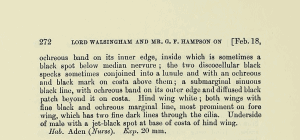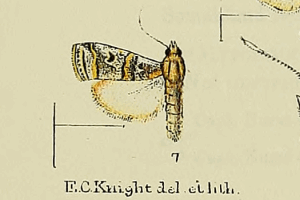

 +10Kontinente:EUASAF
+10Kontinente:EUASAF2. Diagnose
2.1. Erstbeschreibung
3. Biologie
3.1. Nahrung der Raupe
- [Fabaceae:] Vachellia farnesiana ? [= Acacia farnesiana ?] (Süße Akazie ?)
- [Fabaceae:] Vachellia horrida ? [= Acacia horrida ?] (Schreckliche Akazie ?)
- [Fabaceae:] Vachellia tortilis ? [= Acacia tortilis ?] (Schirm-Akazie ?)
Die Raupennahrung von B. metamelana war lange unbekannt. Durch die Einbeziehung von Salebria aumontella als Synonym kann Slamka (2019: 48) aber melden: "Larva (S. aumontella) lives on Acacia farnesiana, A. horrida and A. tortilis (Dumont, 1932)." Wie gut abgesichert die Primärmeldungen sind, ist mir noch unklar.
4. Weitere Informationen
4.1. Etymologie (Namenserklärung)
Slamka (2020) teilt zu dem von ihm publizierten, neuen Gattungsnamen Balqisia mit: „The name was suggested by A. Ö. Koçak, and is derived from “Balqis” – an historical name for the Queen of Sheba. Modern historians identify Sheba with the South Arabian kingdom of Saba, in present-day territory of Yemen (see, for example, [https://en.wikipedia.org/wiki/Queen_of_Sheba]).“
4.2. Andere Kombinationen
- Nephopteryx (Salebria) metamelana Hampson, 1896 [Originalkombination]
- Epicrocis metamelana (Hampson, 1896) [so bis Slamka (2019)]
- Adenia metamelana (Hampson, 1896) [paäokkupierter Gattungsname]
4.3. Synonyme
- Salebria aumontella (Lucas, 1911) [synonymisiert durch Falck et al. (2019) und Slamka (2019)]
- Epicrocis aumontella (Lucas, 1911) [synonymisiert durch Falck et al. (2019) und Slamka (2019)]
- Salebria horridella Dumont, 1932
- Pempelia arida Asselbergs, 2008 [synonymisiert durch Slamka (2019)]
4.4. Taxonomie und Nomenklatur
Falck et al. (2019) nehmen die Kombination mit Epicrocis nur unter Vorbehalt vor, weshalb sie die Art "Epicrocis" metamelana nennen. Sie erläutern: "Salebria aumontella (Lucas, 1911), which was combined with Epicrocis by Leraut (2014: 344), is a synonym of Nephopteryx (Salebria) metamelana Hampson, 1896 (in Walsingham & Hampson, 1896: 271, pl. 10, fig. 7) (syn. n.). The species is here only provisional combined with the genus Epicrocis, and we are unaware of its correct generic assignment."
Slamka (2019: 48) führt für diese Art und mehrere weitere Arten aus dem Nahen/Mittleren Osten den neuen Gattungsnamen Adenia (abgeleitet von "Aden", der Hauptstadt Jemens und Typenlokalität von A. metamelana) ein. Von A. Ö. Koçak auf die Homonymie zu Adenia Robineau-Desvoidy, 1863 (Diptera) hingewiesen, publiziert Slamka (2020) den von Koçak vorgeschlagenen Ersatznamen Balqisia.
(Autoren: Erwin Rennwald und Jürgen Rodeland)
4.5. Faunistik
Locus typicus ist Aden (Jemen).
Falck et al. (2019: 37) melden die Erstnachweise für die Kanarischen Inseln (Fuerteventura und Teneriffa) und damit Europa i.w.S.; zur weiteren Verbreitung schreiben sie: "Tunisia (Leraut, 2014: 344) and Yemen (Hampson, 1896: 272). The records by de Prins & de Prins (2018) from Africa requires confirmation, as the associated photograph shows another species."
Slamka (2019: 48) nennt - unter Einbeziehung von Salebria aumontella und Pempelia arida als Synonyme - außer den genannten Fundorten noch Nachweise aus der Ost-Türkei, Syrien, Palästina, Irak, Oman, Vereinigte Arabische Emirate, Tunesien und Marokko.
(Autor: Erwin Rennwald)
4.6. Literatur
- Falck, P., Karsholt, O. & F. Slamka (2019): New data on Pyraloidea from the Canary Islands, Spain (Lepidoptera: Pyraloidea). — SHILAP Revista de Lepidopterología 47 (185): 33-48. [PDF auf redalyc.org]
- Leraut, P. (2014): Moths of Europe. Volume 4. Pyralids 2. - 441 S.; Verrières-le-Buisson (N.A.P Editions).
- Slamka, F. (2019): Pyraloidea (Lepidoptera) of Europe. Volume 4. Phycitinae - Part 1. Identification - Distribution - Habitat - Biology. - 432 S., 175 Taf. mit Genitalabb., 31 Farbtaf. mit mehr als 900 Bildern zu 207 Arten; Bratislava (Eigenverlag František Slamka).
- Slamka, F. (2020): Balqisia nom. nov. A replacement name for Adenia Slamka, 2019 (Lepidoptera, Pyraloidea, Pyralidae, Phyticinae) preoccupied by Adena Robineau-Desvoidy, 1863 (Diptera, Tachinidae, Exoristini, Exorista (subgen. Adenia)). — The Entomologist's Record and Journal of Variation 132 (2): 8.
- Erstbeschreibung: Walsingham, L. & G. F. Hampson (1896): On moths collected at Aden and in Somaliland. — Proceedings of the General Meetings for Scientific Business of the Zoological Society of London for the Year 1896: 257-283, pl. X. [Digitalisat auf biodiversitylibrary.org]















